Interactive Campaign Templates
The Digital Customer Engagement platform provides the ability to create templates for all Interactive Campaign types to facilitate in the set-up of engaging your customers. To initiate the process of template creation, select the Template icon from the Navigation sidebar on the left side of main pane of the User Interface.
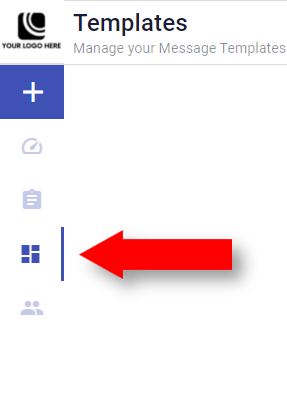
Overview
Before we go into the specifics of the creation of Interactive Campaign templates there are some aspects that are common to all of these types of templates.
TEMPLATE SCOPE
When templates are used in the creation of campaigns, all of the elements of the template, as established within it, will be replicated in the campaign as it is being configured. This includes content, prize configuration settings, color scheme, and other setups in the template. For example, if you disable Prize Configuration in the template, the campaign will inherit this configuration. Take this into consideration as you streamline your process.
Common Template Elements
Throughout the configuration of the templates, campaign images, color settings and campaign prizes are consistently present and need compliance or definition, as described in the following.
Campaign Images
All images that are used in the creation of templates have to be in Portable Network Graphics (PNG) format and their recommended sizes can be found at the bottom of every image drop area in the various sections within the template creation process, depending on their purpose, on where they are used, and the type of campaign that is being created.

Color Palettes
Throughout the various templates configuration sections, there are color setting buttons that modify different elements of the Template design. By default, the settings of these color boxes are given in Hex color code format, but you can introduce codes in HSL and RGB formats as well.

This is accomplished by selecting the colored circle within the color box, to the right of the Hex color code. A palette will pop up from where you can pick the color by moving the selection circles around it, or you can introduce the color code into the box provided at the bottom of the palette in any of the HTML formats. To change the HTML color code format, click on the up-down arrows to the right of the code entry boxes within the palette and it will scroll through the different formats.

Prize Configuration
Interactive Campaigns generally involve giving away prizes to the campaign participants. The prize selection is particular to each campaign and it is an integral part of the campaign design and definition. The platform allows to accomodate any type of prizes, offering flexibility and múltiple customization options broken down in two major groups:
- Standard and the special case of
- Telecom Credit
When it comes to defining templates for interactive campaigns, the platform offers the option to set prizes within the template creation process, or postpone the prize definition for later, either by modifying the template or at the time a campaign is being created.
The definition of prizes is controlled by the Prize Configuration section in each of the campaigns that it is present. The screenshot below shows on the left side the default setting of the Prize Configuration section being enabled which impacts the configuration of the template in the following steps, while on the right side, the Prize Configuration is disabled, reducing the number of elements that need programming in the steps that follow.

Notice that the Reveal Content section adapts to each case, with or without the inclusion of prizes within the template. One case makes it possible to configure the Winner and Loser options, while if the prizing configuration is turned off, the options are limited to Content and Reveal design.
Enabling or disabling the Prize Configuration option at the time of template definition will require different preparation steps at the moment of creating a campaign as in one case fewer steps will be required having had the prizes already defined. With time you will become more adept as to what method suits your requirements best as you develop campaigns that have different degrees of standardization.
Proceeding with the default/enabled setting the steps and options are:
- Choose a Prize Logic to begin adding prizes.

-
Always Win: awards a prize per campaign participation. Normally involves non-tangible prizes such as discounts or free passes to events.
-
Cycles: The Cycles Prize Logic is a prize allocation scheme based on a number of participations. A cycle is defined as a fixed number of participations, for example 100 participations. Prizes are assigned in a random fashion within the cycle.
When you select the Cycles option, it will display three settings: Cycle count, Reset Cycle count daily, One Prize p/ Participant.

The Cycle Count defines the number of participations that represent a cycle. A Cycle Count set to 100 is equivalent to 100 participations, and it represents the population in which the prizes will be randomly awarded.
The Reset Count Daily checkbox controls if the Cycle Count is reset on calendar day boundaries. This is an option that allows further manipulation of the how prizes are allocated. When this option is set, at the end of the calendar day the cycle count will reiníciate the participation count. If left unchecked the participation count will keep advancing until the Cycle Count value is reached.
The One Prize p/Participant check box allows you to restrict the award of prizes to only one prize per participant over the entire campaign.
-
By Exhaustion (Limited Quantities)
Similar to Always Win, By Exhaustion incorporates a feedback notification to the participants once there are no more prizes to be given away in the campaign. -
Random Select: In Random Select prizes are awarded based on a fixed number of predefined participations. The award is controlled through the number in the For every [ N ] participants, randomly award 1 prize from the pool section. For example, if the number is set to 500, prizes will be awarded at the 500th participation. After that, the counter will be reset back to zero and begin counting participations until it reaches 500 again, at which point a new prize to be awarded.

- Once the prize logic is set, prizes can begin to be added to the template. For this, select the Add New Prize box under Prizes section.

Standard
For the most common standard prize definition scheme, a popup window will be displayed with the elements that need to be included for the prize.

- Insert the Prize name. It will be used for identification purposes in platform reports.
- Set the total number of prizes to be awarded.
- Set the number of prizes to awarded per Cycle in the Drops/Cycles entry box, if applicable.
- Insert the image that corresponds to the prizes following the size guidelines at the bottom of the drop area.
- Select either Custom and insert the URL or Campaign and a follow-up campaign from the drop box menu for the prize outcome.
- Select Save.
For more details about campaign prize configurations go the Prize Configuration section under Campaign Elements.
Telecom Credit
ABOUT TELECOM CREDITS
Telecom Credits prize option is only available for accounts that have their Mobile Carriers billing system integrated with the platform.
Unlike the standard prize allocation scheme, Cellular Service Providers that have integrated their telecom billing systems to the platform can provide customized telecom related prizes. In this scenario the New Prize window will be,
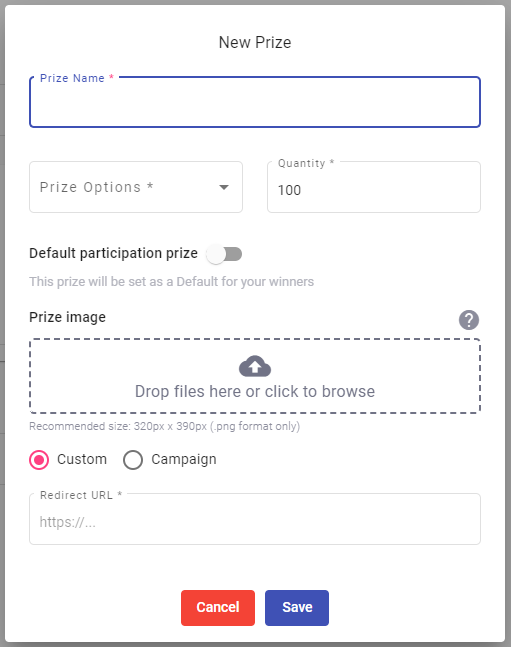
Under Prize Options* the platform will display the following options:
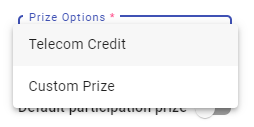
The Telecom Credit option has multiple prizes that can be applied individually or as packages, bundling two or more prizes together. In the figure that follows, there is an overview of all these options that have been arranged as a single prize bundle to illustrate the range of possible configurations in a Telecom environment. In the setup, prizes can be configured in any combination.
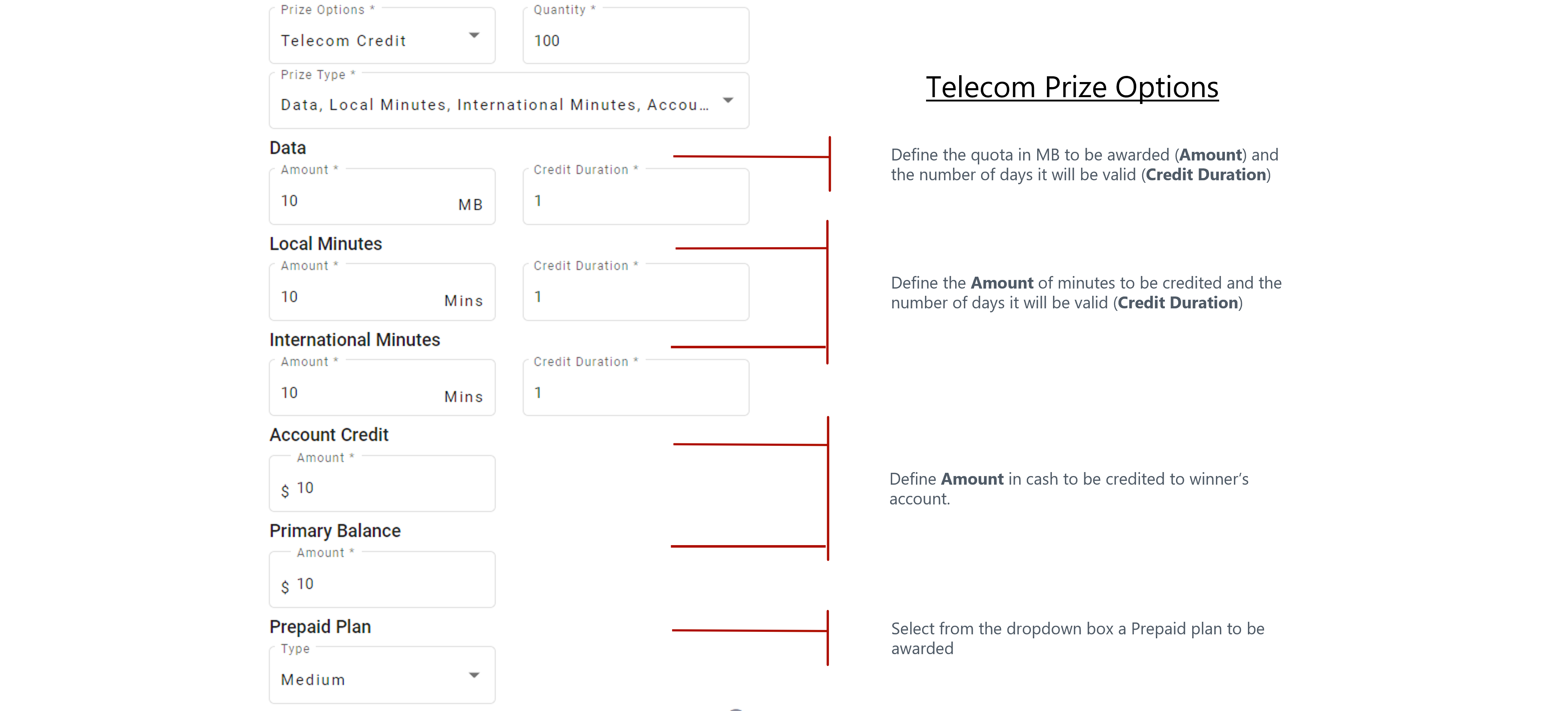
- In the Quantity box, enter the number of prizes that will be awarded of the one being defined. Default value 100
- Select the prize or prizes that fit the award from the Prize Type dropdown box:
- Data,
- Local Minutes,
- International Minutes,
- Account Debit,
- Primary Balance
- Prepaid Plan, or
- Postpaid Plan.
- Include the image corresponding to the prize offering in the area provided,.
- Select either Custom and insert the URL or Campaign and a follow-up campaign from the drop box menu for the prize outcome and save the prize.
- Repeat this sequence as many times as prize variations need to be configured in the platform.
The Custom Prize option is where Telecom operators can set all non telecom related prize types, prizes that are not directly related to telecom features. The elements that are required are depicted in the figure.
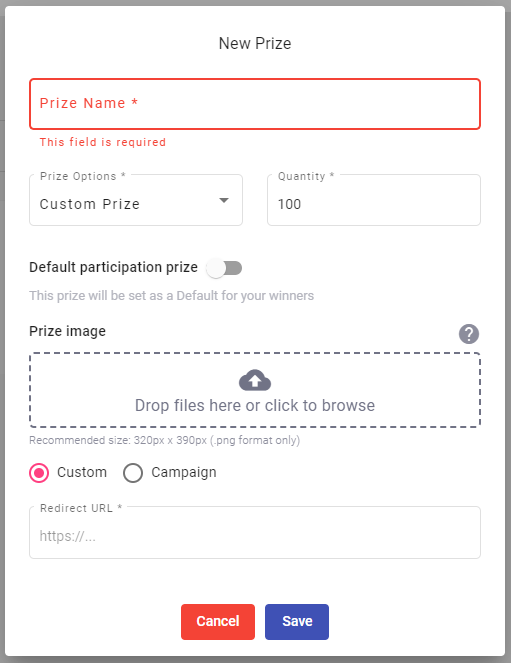
After entering the Prize Name and selecting Custom Prize under the Prize Options proceed with the following:
- In the Quantity box, enter the number of prizes that will be awarded of the one being defined. Default value 100
- In Prize Type include a prize type that is representative of your requirements
- Set Amount associated with the prize
- Include the image corresponding to the prize offering in the area provided.
- Select either Custom and insert the URL or Campaign and a follow-up campaign from the drop box menu for the prize outcome and save the prize.
- Repeat this sequence as many times as prizes needed to be configured in the platform.
As prizes are added to the template, a table that includes the prizes is progressively assembled at the bottom of the Prizes area. An example of a table with three prizes follows.

At the end of each entry in the Prize table are two Actions options that allow you to either edit or delete a prize of the template that is being created.
Creating an Interactive Campaign Template
Once you have decided to create an Interactive Campaign template, as before, select the New Template button on the top right side of the main panel of the User Interface.

From the emerging popup window, select the Interactive Campaign you are interested in creating from the list or type the campaign type in the search box.

Another popup window appears with two options, as shown in the next screenshot. Create Blank Template gives the option to define a totally new template, or you can select a template to clone one from the list in the table, if there were to be any templates that had been previously created.
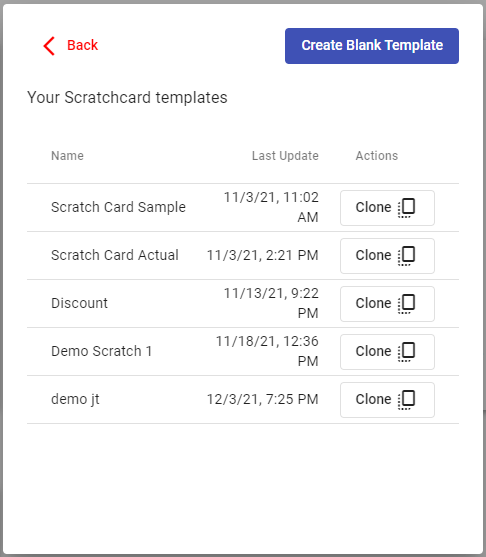
From this point on, the platform directs you to the creator that is specific to the selected template. Click on one of the links below to see the details of the template type you interested in creating.
-
Reveal Campaign Templates : Scratch Card, Peel It, Crack The Ice
The list above will grow in time as more templates types are added to the platform.
Updated over 1 year ago
